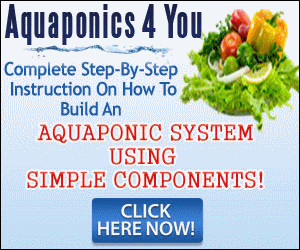
Over the past 21 months I have experimented with variations and combinations of Aquaponics, (vertical towers, wicking pots, deep water culture, and media beds), plus several other gardening methods such as Bio-Ponics, Wicking Beds, Hugelkultur, Two forms of Hydroponics (Dutch Bucket Hydroponics, and Kratky Method), and Dirt.
What I discovered worked best for me was all of the ponic methods -Aquaponics, Hydroponics, and Bio-Ponics The Kratky Method (a form of Hydroponics) also worked well.
Wicking beds or Wicked Beds as the Aussies like to say, provide uniform moist soil, even when I forget to water, and they conserve water due to the bottom up watering method.
The Ponics which are not normally soil based, provide nutrient rich water on a regular basis.
I am now ready to combine the techniques that I found worked best for me. I was working toward this conclusion when I saw this link to the Earthen Group. The details of this solution were instantly clear to me. Paul Van der Werf appears to have worked out all the kinks, and has detailed the construction of his system in the link above.
What I discovered worked best for me was all of the ponic methods -Aquaponics, Hydroponics, and Bio-Ponics The Kratky Method (a form of Hydroponics) also worked well.
Wicking beds or Wicked Beds as the Aussies like to say, provide uniform moist soil, even when I forget to water, and they conserve water due to the bottom up watering method.
The Ponics which are not normally soil based, provide nutrient rich water on a regular basis.
I am now ready to combine the techniques that I found worked best for me. I was working toward this conclusion when I saw this link to the Earthen Group. The details of this solution were instantly clear to me. Paul Van der Werf appears to have worked out all the kinks, and has detailed the construction of his system in the link above.

class="separator" style="clear: both; text-align: center;">
http://youtu.be/lkSMkTpdt7U
http://www.earthangroup.com.au/earthan-beds-how-they-go-together/
Since I built my Wicking Beds as conventional raised beds, and used sand in the reservoir I will have to replace that sand with 1-1/2" drainage rock in order to facilitate the faster movement of water from the Bio-Ponic or Aquaponic system. Im leaning towards Bio-Ponics because Im not into eating fish, and it comes with less overhead. Either way the nutrients will flow below the soil in the Wicking Beds.

This should create a very large area for nitrification, and be very good for the fish if I choose that path. CLICK HERE FOR UPDATE
I considered utilizing one bed for the soul purpose of vermicomposting Eisenia Hortensis (European nightcrawler) or more likely Eisenia Foetida (the red wiggler, Californian red worm). But the leachate from a worm bin would not be beneficial to an aquaponic or even a bio-ponic system.
Converse wrote a very good description of the risks involved. [LINK]
To be clear- keeping red wigglers in all of your grow beds is a good idea, but the leachate created in composting worm bins is better suited for a Bokashi Compost than used directly in the garden, or introduced to aquaculture, so even though it may sound like it would increase the micro-nutrients in the soil, it is not recommended.


http://youtu.be/lkSMkTpdt7U
http://www.earthangroup.com.au/earthan-beds-how-they-go-together/
Since I built my Wicking Beds as conventional raised beds, and used sand in the reservoir I will have to replace that sand with 1-1/2" drainage rock in order to facilitate the faster movement of water from the Bio-Ponic or Aquaponic system. Im leaning towards Bio-Ponics because Im not into eating fish, and it comes with less overhead. Either way the nutrients will flow below the soil in the Wicking Beds.

This should create a very large area for nitrification, and be very good for the fish if I choose that path. CLICK HERE FOR UPDATE
I considered utilizing one bed for the soul purpose of vermicomposting Eisenia Hortensis (European nightcrawler) or more likely Eisenia Foetida (the red wiggler, Californian red worm). But the leachate from a worm bin would not be beneficial to an aquaponic or even a bio-ponic system.
Converse wrote a very good description of the risks involved. [LINK]
To be clear- keeping red wigglers in all of your grow beds is a good idea, but the leachate created in composting worm bins is better suited for a Bokashi Compost than used directly in the garden, or introduced to aquaculture, so even though it may sound like it would increase the micro-nutrients in the soil, it is not recommended.


0 komentar:
Posting Komentar